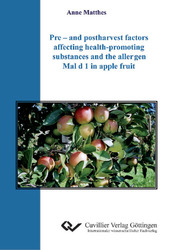| Fachbereiche | |
|---|---|
| Buchreihen (96) |
1378
|
| Nachhaltigkeit |
3
|
| Gesundheitswesen |
1
|
| Geisteswissenschaften |
2364
|
| Naturwissenschaften |
5406
|
| Mathematik | 229 |
| Informatik | 319 |
| Physik | 980 |
| Chemie | 1363 |
| Geowissenschaften | 131 |
| Humanmedizin | 243 |
| Zahn-, Mund- und Kieferheilkunde | 10 |
| Veterinärmedizin | 108 |
| Pharmazie | 147 |
| Biologie | 835 |
| Biochemie, Molekularbiologie, Gentechnologie | 121 |
| Biophysik | 25 |
| Ernährungs- und Haushaltswissenschaften | 45 |
| Land- und Agrarwissenschaften | 1004 |
| Forstwissenschaften | 201 |
| Gartenbauwissenschaft | 20 |
| Umweltforschung, Ökologie und Landespflege | 148 |
| Ingenieurwissenschaften |
1793
|
| Allgemein |
98
|
|
Leitlinien Unfallchirurgie
5. Auflage bestellen |
|
Erweiterte Suche
Pre – and postharvest factors affecting health-promoting substances and the allergen Mal d 1 in apple fruit
Anne Matthes (Autor)Vorschau
Inhaltsverzeichnis, Datei (29 KB)
Leseprobe, Datei (59 KB)
The key objective of this work was to evaluate the influence of certain biotic and abiotic factors on the amount of health-promoting substances, such as ascorbic acid and polyphenols and health affecting substances, such as the major apple allergen Mal d 1, in apple fruit. For these studies a high number of different apple cultivars were selected and screened for their amount of bioactive components. Some cultivars were stored for different periods under various conditions. Mechanisms leading to Mal d 1 synthesis during storage have not been unveiled thus far. In this work the effect of 1-MCP, as an ethylene inhibitor, on Mal d 1 synthesis during storage was evaluated. The choose of cultivar, any agronomical practices and proper storage conditions might give the possibility to provide apple fruit with high amounts of health promoting substances and at the same time low amounts of the allergen Mal d 1. The results can be summarized as follows:
A high content of polyphenols and antioxidants can be maintained by optimal storage conditions. No differences between cold storage and storage under controlled atmosphere could be detected, whereas shelf life led to lower content in antioxidants. Pearson’s coefficient of correlation showed a positive correlation between polyphenols and antioxidant capacity. Cultivar had a strong effect on the amount of secondary plant metabolites.
Mal d 1 content was quantified by Sandwich-ELISA. The apple cultivars differ in Mal d 1 concentrations. We determined a high variability in Mal d 1 content within one cultivar and between two orchards, Klein-Altendorf and Bavendorf. This shows that environmental conditions had a great impact on Mal d 1 synthesis. In most cases integrated produced fruit showed higher Mal d 1 amounts in comparison to fruit from organic cultivation. During storage a significant increase in Mal d 1 content was observed.
Harvest maturity did not influence polyphenol content, ascorbic acid content and antioxidant capacity at harvest as well as storability of apple fruit in regard to polyphenols. Genetic differences between the cultivars seem to have a higher impact than stage of ripeness. Phytochemicals can be maintained during storage in a cold chamber. This especially counts for polyphenols and for ascorbic acid to a lesser extend.
Fruit of different apple cultivars were screened for their content of health-promoting substances as well as Mal d 1 at harvest and different terms of postharvest storage. The stage of ripeness seems to have no impact on storability in regard to Mal d 1 content and polyphenoloxidase activity. Mal d 1 content increased during storage whereas polyphenoloxidase activity remained on a high level. No relationships were found between Mal d 1 content and PPO activity and polyphenol content, respectively.
1-MCP-treatment decelerated Mal d 1 synthesis in stored ‘Golden Delicious’ fruit. This could especially be seen during the first 8 weeks of storage. Mal d 1 synthesis started again if the fruit were further stored. This may be due to synthesis of ethylene receptors.
| ISBN-13 (Printausgabe) | 3869553820 |
| ISBN-13 (Printausgabe) | 9783869553825 |
| ISBN-13 (E-Book) | 9783736933828 |
| Sprache | Englisch |
| Seitenanzahl | 106 |
| Auflage | 1 Aufl. |
| Band | 0 |
| Erscheinungsort | Göttingen |
| Promotionsort | Universität Bonn |
| Erscheinungsdatum | 24.06.2010 |
| Allgemeine Einordnung | Dissertation |
| Fachbereiche |
Gartenbauwissenschaft
|








